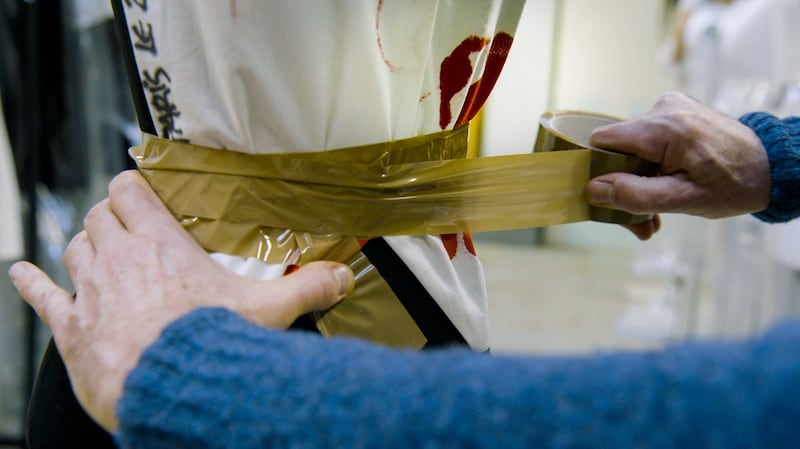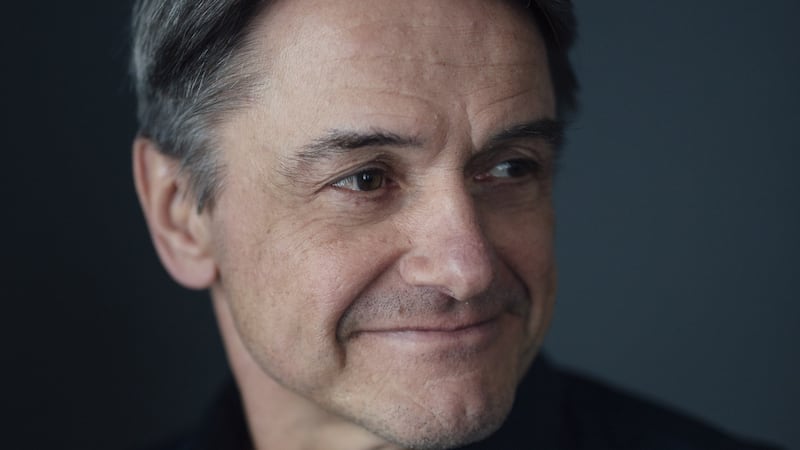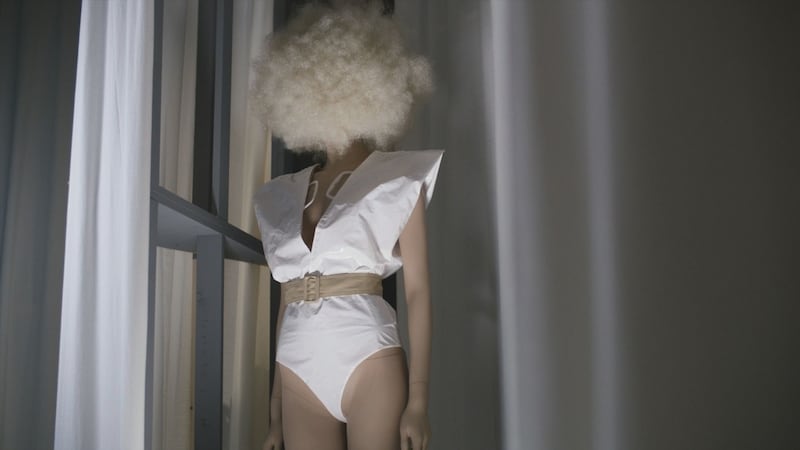It’s not easy being a recluse in the information age. But at a time when Sia has emerged from behind her wig, and Thomas Pynchon, the great literary enigma, has voiced himself on The Simpsons (albeit drawn with a paper bag over his head), Martin Margiela remains a mystery. Now, a decade after the influential Belgian fashion designer’s sensational retirement, a new documentary attempts to get to know the man known variously as the Banksy or Garbo of fashion. Early in director Reiner Holzemer’s Martin Margiela: In His Own Words, the designer’s former boss Jean-Paul Gaultier asks and answers his own question: “Who will get [Margiela] to emerge from his shell? But he never did. He never showed himself. That’s incredibly powerful.”
Throughout his career, Margiela maintained a low-to-no personal profile. No photograph of the designer has ever been released: the only known photo, taken in 1997 by Marcio Madeira, has never been officially verified. After every show, he remained backstage. And until now, he has refused all interviews. “The most important thing was to get him to talk because he never talked before,” says Holzemer. “I’m not a fashion expert. I know who Karl Lagerfeld is. But everybody in Germany knows who Karl Lagerfeld is. I’m interested in interesting people. And five or six years ago, I hear the name Margiela. He’s a mysterious figure. And he’s the missing part of fashion history. Nobody can say what his work is about.” Finding Margiela has been an ongoing adventure for Holzemer. The German director had filmed more than 30 documentary portraits, mostly of photographers (including William Eggleston, Anton Corbijn, Juergen Teller, and René Burri) when a story, written in the aftermath of John Galliano’s 2011 anti-Semitic rant, caught his eye.
“There was a big article in a German newspaper about the pressure that is put on creative people in the fashion industry,” recalls Holzemer. “How they have to make so many shows and collections. That interested me. So I thought about following a fashion designer. I had done a documentary about Juergen Teller. And he does a lot of fashion photography. That’s how I met Dries.”
Hermès roots
Dries is Dries Van Noten, the Belgian fashion designer and the subject of Holzemer’s fascinating 2017 documentary, Dries. That film sold in some 64 territories around the world and was warmly received at more than 20 festivals. Coming from the Antwerp premiere, Holzemer wandered into MuMo, the city’s fashion museum, and found a collection from Margiela’s six-year stint as creative director at Hermès. “I loved it,” says Holzemer. “I saw that the outfits and clothes and collections – they were about 15 years old but I thought they were so timeless and so elegant. It was incredible. Normally when you go to a museum show about fashion, it’s dated, it’s temporary. And alongside the Hermès pieces, there were also five or six pieces from Maison Martin Margiela. And they were so different from the rest of the exhibition.”
Reteaming with his Dries co-producer Aminata Sambe, who has worked with Hermès and has extensive contacts throughout the industry, Holzemer attempted to make contact with the elusive designer, though various ex-models and through fashion historian Olivier Saillard. Finally, eight months after reaching out, the director received a reply. “There came a mail from Martin saying we could meet in Paris,” says Holzemer. “You can’t imagine how excited I was to read that. My heart was beating so fast. Then I became afraid – what happens if he doesn’t like me or I say something wrong? So we met in January 2018. I have no idea what he looks like. There was a woman and two men in the room. I have to guess. But was very casual. It was like meeting a person that I have met several times before. He had seen my previous movie. I told him I was open to anything. I didn’t want to scare him off and then for him to disappear again.”

Two years on and Martin Margiela: In His Own Words has been hailed as one the greatest fashion documentaries. Shot over 42 days alongside the preparation and installation of the Palais Galliera’s 2018 exhibit, Margiela/Galliera, 1989-2009, Holzemer, either alone or with a skeleton crew, would visit the museum or Margiela’s studio to interview him. Well, that’s not the word Margiela would use.
No interviews
“I was hoping that, for in the case of Martin that, maybe, as with other subjects, that after a few hours or a few days, he would feel comfortable,” says the director. “At that first meeting, he said, if we want to do this movie, we have to start quickly, because the outfits will soon be arriving for the show, and once they’re in the exhibition, we cannot touch them. Five days after we met, the first clothes arrived. I did not dare to ask anything on the first day. There was a catalogue for the exhibit and I asked how did the museum get all that information? Did you do an interview? And Martin said: ‘No, no, no; I never give interviews.’ So I always used the word conversations after that. I avoided the word interview for the whole shoot.”
Despite the reluctant subject, an engaging and detailed portrait emerges in the film. Born in 1957 in Leuven to a Polish father and a Belgian mother, Margiela attended the Royal Academy of Fine Arts in Antwerp, a near-contemporary of the fashion collective known as the Antwerp Six. Influenced by his grandmother and an early doll collection – which appears in the film courtesy of Margiela’s mother, Léa Bouchet – the young designer worked in Milan and later Paris, as an assistant to Gaultier, before striking out with his own game-changing collection. “I was expecting it to be good,” recalls Gaultier. “But I didn’t expect it to be that good.” At a moment when other designers were luxing out, using supermodels, and embracing stardom, Margiela was visiting thrift shops and making coats from wigs and duvets, tops from plastic, paper and insulation tape, and catwalk casting from the street, with an eye for interesting walks and shapes. He veiled his models’ faces or obscured them with paint or wigs. Working at the cutting edge of deconstructed forms, coloured dyes frozen in ice cubes melted into garments as they were modelled and hangers stayed in the garments down the catwalk. The shows took place in odd venues: an impromptu circus tent, or using shuttle buses. “It was a real change in fashion,” says Carla Sozzani, the Italian magazine editor and gallerist. “It was the last revolution we had in fashion.”
‘Perverted’ system
Experts concur. “Martin Margiela is different from others because he never compromised his point of view,” said Olivier Saillard in 2015. “He established a vision. And concentrated on reconfiguring an entire system of fashion. He didn’t only introduce new clothes; he commented on the system which was then already very perverted and dominated by money.”

Margiela’s designs are “modern classics,” said Alexander McQueen. “He’s in the top 10 [designers] of all time,” says former New York Times critic Cathy Horyn, “Going back to the 19th century.”
Margiela’s reluctance to step into the limelight, he says, made the work better. With no one to front the business, the clothes had to stand on their own merits. “I don’t like the idea of being a celebrity. Anonymity is very important to me . . . I always wanted my name to be linked to the product I created, not to the face I had.” That face never appears in Martin Margiela: In His Own Words; only his hands and his voice are on screen. That turns out to be more than enough.
“At the very beginning he was talking about written conversations, about maybe inserting text,” says Holzemer. “He didn’t want to talk at first. He said he didn’t like his voice. It took a while to convince him. We had a contract that we cannot show his face. But I didn’t have a problem with that. If you made a movie about Van Gogh, you would have to piece it together with diaries and notes. I asked about shooting him in shadow or out of focus, but he said no. But of course we needed images and he felt very safe when I could put something in his hands and he could talk about his inspirations and his childhood memories. And he has beautiful hands. The way he hangs things on the wall is very elegant. One of his models called it finesse. We had a festival screening in New York and three screenings in Paris and people never asked about the hands. So I would ask them: did you miss the face? And everybody said no. They knew him through the voice and hands.”

By 2002, Maison Martin Margiela had boutiques in Paris, Brussels, and Tokyo. Four years later, on the evening of the show celebrating the 20th anniversary of Maison Martin Margiela, Martin Margiela quit his own company and disappeared. “We were growing very fast,” he says simply. “There are different needs in the fashion industry and I’m not sure I can feed them.” The designer retains such an aura and cult following that last week the entirety of Martin Margiela: In His Own Words landed on PornHub. Holzemer’s film ends with a glimmer of hope for diehard (and possibly PornHub-loving) fans, as the director wonders if the designer has “told everything you want to tell in fashion?” “No,” comes the characteristically intriguing response.
Martin Margiela: In His Own Words is available on demand now











